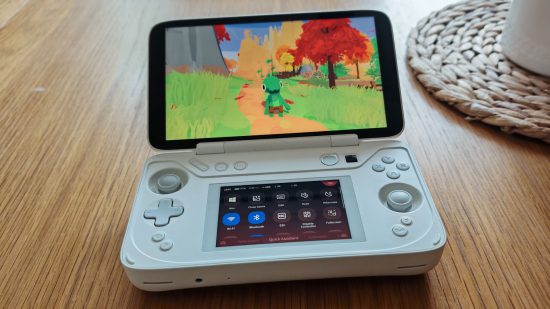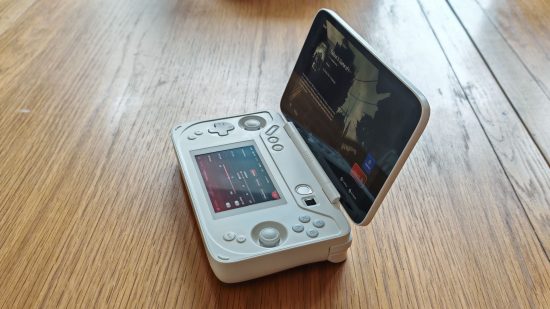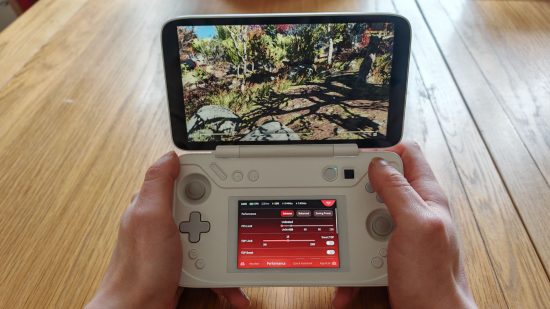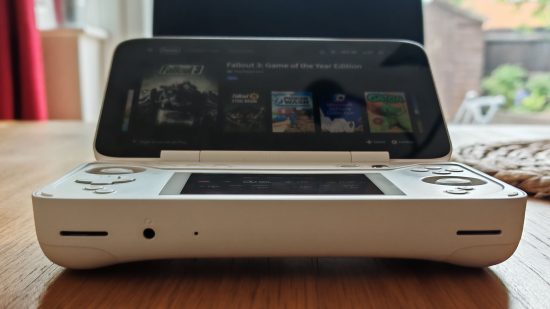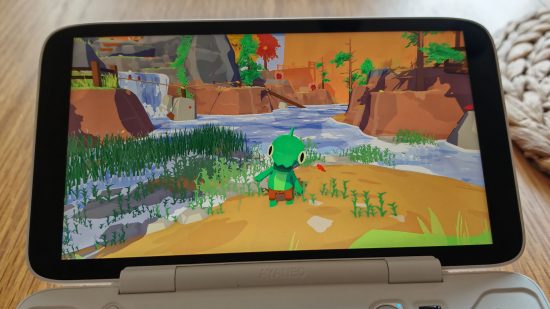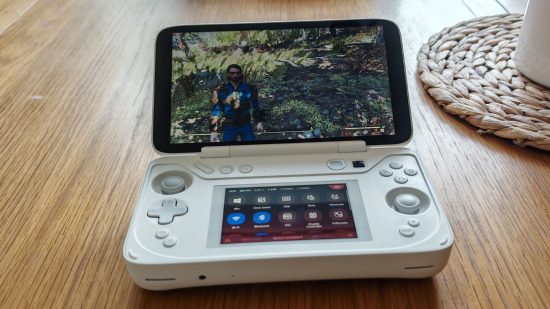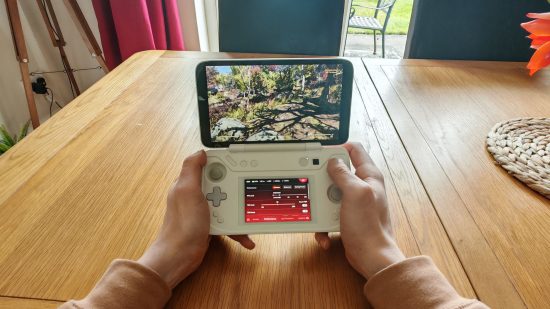Our Verdict
The AYANEO Flip DS is my new go-to for handheld gaming, with a fantastic form factor, industry-leading performance, and crystal clear display. It might be too expensive for some and suffers some of the battery life problems of other portable consoles, but otherwise, I’d happily recommend the AYANEO to anyone looking for their next handheld console.
- Incredible performance
- Vivid displays
- Solid charging speeds
- Two screens are better than one
- Expensive
- Not the best battery life
- Can run hot
Since arriving on the portable console scene in 2020, AYANEO’s contribution to the industry includes a long list of impressive devices with Windows operating systems and AMD Ryzen processors. Despite not being the biggest name on the scene and a slightly mixed bag in terms of critical reception, this is a brand leading the way in terms of innovation, and in 2024 it’s pushing the envelope further still.
The AYANEO Flip DS is one of the latest products from the company, taking obvious inspiration from its Nintendo namesake to offer a nostalgic gaming experience that doesn’t turn back time when it comes to performance, visual quality, or storage. However, the big caveat here is the price, with the Flip DS arriving as one of the most expensive portable gaming consoles on the market. So, is it worth it? Let’s find out.
Price and availability
As we’ve already mentioned, the AYANEO Flip DS is an expensive bit of kit. With six different specifications, you’re paying either between $939-1479 through the AYANEO site in the coming months, or $839-1399 via the Indiegogo campaign, which is due to wrap up shortly. Even at its cheapest, it’s $200 more than the Steam Deck OLED and $100 more than the Lenovo Legion Go. We’ve listed all the retail prices below.
| AMD Ryzen 7 7840U | AMD Ryzen 7 8840U | |
| 512GB storage and 16GB RAM | $939 (retail) / $839 (Indiegogo) | $979 (retail) / $879 (Indiegogo) |
| 2TB storage and 32GB RAM | $1169 (retail) / $1099 (Indiegogo) | $1209 (retail) / $1139 (Indiegogo) |
| 2TB storage and 64GB RAM | $1439 (retail) / $1359 (Indiegogo) | $1479 (retail) / $1399 (Indiegogo) |
For this review, we tested the AMD Ryzen 7 7840U unit with 64GB of RAM and 2TB of storage.
Specs
Features and software
Let’s start with the obvious big draw feature of the AYANEO Flip DS: it has two screens. The top display is where most of the action happens, and if like me, you mainly use the thing for Xbox Game Pass games, you’re rarely going to use the bottom display for actual gaming. You can if you’d like, but I tend to use it to keep tabs on performance via the AYASpace application.
What is the AYASpace app, I hear you ask. Well, it’s AYENEO’s custom software, which you can access via the bottom screen or by pressing the AYANEO button at the bottom right of the console to pop up on the primary display. Here, you can check your CPU and GPU performance, tinker with things like thermal design power and frame rates, or use the Quick Assistant function to bring up the on-screen keyboard, minimize windows, and perform other quick tasks. It’s a remarkably useful bit of software.
We’re not going to delve too deeply into emulation here as, well, it’s a dicey subject area. Still, as this is a Windows-based device, you can basically run any emulation software on the Flip DS and enjoy a smooth experience from download, to installation, to play. It might require a bit of fiddling if you want to use both screens, but it’s possible.
Design
The design of the AYANEO Flip DS is what helps it stand out from the crowd, after all, it’s the only dual-screen clamshell portable console in town. I’ve got the white version – you can pick between Milky White and Shadow Black – which looks like a scaled-up version of my old Nintendo DS Lite, and I’m an absolute sucker for a clean-looking clamshell. Open that bad boy up and you’ve got your lower panel, complete with recessed analog sticks, a bunch of buttons, and a screen, with the top half made up entirely of the IPS display.
Considering the price of the AYANEO Flip DS, I was expecting a solid build and good news, folks, that’s what I got. The folding screen isn’t flimsy and has locking angles at 120°, 150°, and 180°. I found 150° to feel the most natural, while 180° feels a little weird and infringes on your access to the additional buttons next to the bumpers, but this is an each-to-their-own scenario. You can float between these angles, but it won’t lock in, so even the slightest nudge might push it to the closest locking point.
I have a couple of criticisms of the design, though. For one, there might be a few too many buttons. There’s a grand total of 10 buttons on the bottom half of the device, not counting the d-pad, power button, volume controls, a tiny optical finger mouse clicker, and two Hall sensor analog sticks, which can make the layout feel a bit congested and requires a little getting used to. Then, there are three shoulder buttons on each side of the Flip DS. Fortunately, all these buttons are nice and clicky – I love a clicky button – and feel better in practice than those of the Nintendo Switch or Steam Deck, there’s just a lot of them to contend with.
It could also be a bit lighter. It’s not a problem for short gaming sessions, but after a while, I could feel my hands start to strain due to the relatively hefty nature of the device. It’s a little lighter than the Steam Deck OLED, but since the Deck’s weight is distributed over a wider area, it doesn’t always feel that way. I can only imagine how difficult it is to pack all this tech into a small device, but if I had one wish to change the build, it would be to make it a touch lighter, or even wider, to make longer play sessions more comfortable.
Display
The AYANEO Flip DS boats a glorious 7-inch 1080p IPS dynamic touchscreen display with a 120Hz refresh rate. That means games on this thing look incredible, and you’ve got the option of navigation via either touch controls, the optical finger mouse, or the analog sticks. I tend to go with touch controls paired with the on-screen keyboard that you can easily bring up using the Quick Assistant feature on the bottom screen, but they all work as well as each other.
That bottom display we just mentioned is a 3.5-inch IPS touchscreen which isn’t quite as glorious as the primary display but certainly gets the job done. As we alluded to earlier, you have complete control over what you want to use this bottom display for. I tend to monitor performance on the lower screen with the AYASpace app, but you could use it to stream YouTube content while you game on the top half, as a clock, or whatever else. This freedom of use is quite refreshing, and it wouldn’t be a surprise if it got other console brands thinking once again about the possibilities of dual-screen devices.
In my testing, I tried out some distinctly different-looking games, from Fallout 4 to Another Crab’s Treasure to Lil Gator Game, and in all cases, the visuals look fantastic. There’s a real depth of colors and blacks, and thanks to the processing power of the AMD Ryzen 7, the frame rate is always silky smooth. It’s nice and bright, too, with a peak brightness of 550 nits. Providing you’re not playing right under the midday sun, you should have no issue in any lighting scenario.
Performance
The performance on the Ayeneo Flip DS is fantastic. If you just want the basic information, you can take that fact and run with it. Of all the portable consoles I’ve tried, Windows-based and non, this is up there with the best for running AAA titles – which is almost ironic considering its Nintendo DS influence. Baldur’s Gate 3? No problem. Fallout 76? Smashes it. You might have to tinker with the TDP and frame rate settings in the AYASpace menu to make sure you get more than an hour of battery life, but in terms of gaming performance, this thing is no slouch.
Why is the performance so incredible? It probably has something to do with the AMD Ryzen 7 processor inside the AYANEO Flip DS, a CPU notorious for offering stellar gaming without taking up too much physical space. Regarding frame rate, I was almost always running at around 60fps in games like Fallout 4, PowerWash Simulator, and Another Crab’s Treasure with TDP locked at 15W, with no instances of notable dips. If you boost TDP to its maximum 28W, you can get into higher frame rate numbers, but the fan starts to make the thing sound a bit like it’s about to take off. For me, 15W and locked at 60fps is the sweet spot.
Stellar performance is all well and good but there’s nothing worse than a device running hot and melting your hands while you’re trying to roll back the years and play a bit of Fallout 4. Admittedly, the Flip DS can run pretty warm, especially if you’re playing a performance-intensive game. It never gets too hot, though, except if you place the console down to do something else for a couple of minutes with a game still running. Then, it can get pretty toasty. This can be a bit of a nuisance, but it’s easily avoidable if you just remember to pop the thing on standby mode before putting it down for a little break.
Fortunately, the robust cooling system and internal fan do a respectable job of keeping the device cool while gaming. You can either set the fan speed yourself or rely on the smart fan configuration, like I do, to determine the fan speed. The rest is left to the VC heat dissipation plate, which, for the most part, does a grand job of maintaining the temperature.
Battery
Battery life is the sword by which portable consoles and PCs live and die, and it’s a mixed bag for the AYANEO Flip DS. Unless you get creative with performance controls, this thing’s 45Wh battery can run out of juice pretty quickly, but on the bright side, it’s a relatively rapid charger. It might be a controversial opinion, and I’m someone who tends to use portable consoles in the comfort of my own home rather than on the road, but I’d rather have something with a middling battery life that charges relatively quickly than a longer battery life that takes forever to juice back up.
In terms of numbers, with TDP at 15W, I tend to get about two hours of play before I need to charge, and at the maximum 28W TDP, it’s more like an hour. Like most of the portable consoles on the market right now, it’s really a trade-off between performance, visual quality, and battery life. As I’m playing mostly at home, I don’t mind boosting the TDP and frame rate, but you can lock it right down to 3W and a lower frame rate if you’re trying to get as much battery life out of the device as possible.
While playing a game, the Flip DS charges at a rate of around 25% every 30 minutes. If charging while the device is off, it’s closer to 40% every 30 minutes. Either way, you’re getting a full charge in less than two hours, well under if the power is off, which isn’t quite as rapid as the Steam Deck OLED but matches the ASUS ROG Ally and beats out the Lenovo Legion Go. It’s plenty quick enough for me, but there’s room for improvement in future iterations.
Should you buy the AYANEO Flip DS?
Sure, the AYANEO Flip DS is expensive, and its battery life could be better, but here’s the thing. I love it and would happily recommend it to anyone looking for a new portable console. There’s something about this form factor combined with serious hardware that makes for a gaming experience that feels like it’s worthy of a place in handheld history. It’s rare that a company tries to mix nostalgia with innovation, but in this instance, it really works, and those who grew up clinging to a Nintendo DS have a real treat on their hands with the Flip DS.
Still, it’s not perfect. The pricing is hard to look past, especially in the current economic climate, and if you rely on battery life for gaming on the go, you may find the rate of battery drain pretty frustrating. That isn’t to mention a couple of my other quibbles, like the weight distribution causing strain during some longer play sessions and how warm it can get.
The fact of that matter is that these issues aren’t unique to the Flip DS and come into play when analyzing almost all the portable gaming PC units on the market, so it’s hard to mark it down on these factors. All I know is that I’m going to miss this review unit when it’s gone, and I don’t always say that about the devices I try out, even if they’re this impressive.
Alternatives
If I haven’t sold you on the AYANEO Flip DS, here are a couple of alternative suggestions you might want to check out.
Steam Deck OLED
This is a pretty obvious alternative, and we’ve already mentioned it a couple of times in this review, but the Steam Deck OLED is a great choice, especially if it’s the pricing or battery life scaring you off the AYANEO Flip DS. It all depends on how much you value the second screen of Ayeneo’s console, and how easy the Flip DS’ Windows operating system is to use compared to the Steam Deck’s reliance on Linux, but that’s a decision for you to make. For more on this option, see our Steam Deck OLED review.
Lenovo Legion Go
Much like the Steam Deck OLED, the Lenovo Legion Go is another sensible alternative to the AYANEO Flip DS. The big draw of the Legion Go is its detachable controllers à la the Nintendo Switch, though it’s a little more complicated to get to grips with in terms of software when compared to the AYANEO. For our in-depth thoughts on this alternative, check out our Lenovo Legion Go review.
